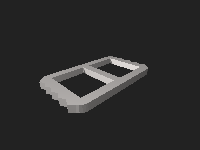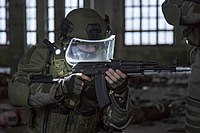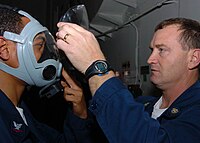Face shield

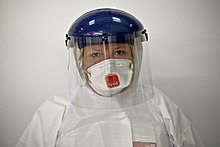
Aface shield,an item ofpersonal protective equipment(PPE), aims to protect the wearer's entireface(or part of it) fromhazardssuch asflying objectsandroad debris,chemical splashes (inlaboratoriesor inindustry), or potentiallyinfectiousmaterials (inmedicaland laboratory environments). Depending on the type used, a face shield may protect its wearer from a physical hazard, chemical splashes, or biological hazards.[1]
Industry
[edit]A face shield is intended to protect the wearer's partial or entire face and the eyes from hazards. Face shields should be used withspectaclesand/orgoggles.[2]
Standards
[edit]- ANSI(American Standard)
- Mark Z87: Basic impact: Faceshields shall be capable of resisting impact from a 25.4mm(1in) diameter steel ball dropped from a height of 127cm(50 in).
- Mark Z87+: High impact: Faceshields shall be capable of resisting impact from a 6.35 mm (0.25 in) diameter steel ball traveling at a velocity of 91.4m/s(300 ft/s).
- EN 166(European Standard)
These shields are for protection against high-speed particles, and must withstand the impact of a 6 mm nominal diameter steel ball, striking the oculars and the lateral protection at the speed stated.
- Mark A: 190 m/s (620 ft/s)
- Mark B: 120 m/s (390 ft/s).
- Mark F: 45 m/s (150 ft/s).
- ref. EN166
- CSA(Canadian Standard)
Z94.3-15Eye and Face ProtectorsClass 6 relates to face shields, and is divided into 3 sub-classes
- 6A – Impact, piercing, splash, head, and glare protection.
- 6B – Radiation protection. Also for low heat, splash, glare, and light non-piercing impact protection.
- 6C – High-heat applications and light non-piercing impact protection only.
- ref. CSA Z94.3-15
See alsowelding helmet.
Materials
[edit]- Polycarbonate(PC)
Provides excellentimpact resistance,optical quality,heat resistanceand normalchemical resistance.
Provides normal impact resistance, optical quality, heat resistance and good chemical resistance.
Manufacturing
[edit]Two methods are used to manufacture face shields:extrusionandinjection molding.Faceshields cut from extrusion sheets provide betterimpact resistancethan injection molded faceshields because extrusion sheets are made of highmolecular weightplasticpellets while injection molding must use lower molecular weight plastic pellets, which provide bettermelt flowingproperty needed by injection molding. For example, even faceshields 0.8 mm (0.031 in) thick made of extrusionpolycarbonatesheets can withstand the impact of a 6 mm (0.24 in) nominal diameter steel ball traveling at the speed 120 m/s (390 ft/s) (European standard, protection against high-speed particles – medium energy impact), while injection molding faceshields must have at least 1.5 mm (0.059 in) thickness to withstand the same impact. But injection molding can provide more complicated shape than extrusion.
During theCOVID-19 pandemic,people from 86 countries engaged in the voluntary production of PPE to supplement traditional supply chains - many of which had been interrupted.[3]They collectively produced a total of 25 million face shields with techniques including3D printing,Laser cutting,Injection molding.
-
3D printing of face shields during COVID-19 pandemic
-
3D file for printing a face shield[4]
-
Buckle for the face shield
-
Final shield
Medical
[edit]This sectionneeds expansion.You can help byadding to it.(April 2020) |

Inmedicalapplications, "face shield" refers to a variety of devices used to protect a medical professional during a procedure that might expose them tobloodor other potentially infectious fluids. An example is the use of aCPR maskwhile performingrescue breathingorCPR.Another example is the use ofpersonal protective equipmentto guard the face against exposure to potentially infectious materials.
Police and military
[edit]-
Russian combat engineerwith a 6B47 helmet and ballistic face shield
-
Removing a face shield from a Sailor's MCU-2/P gas mask after washing it with decontamination solution during a General Quarters Drill aboard an aircraft carrier
Inmilitaryorlaw enforcementenvironments, a face shield may be designed for ballistic or non-ballistic protection. The non-ballistic shield will provide no protection from projectiles shot from firearms,[5]but is usually designed to withstand low velocity impacts, like caused by punches or thrown objects.[6]
A ballistic face shield is designed to stop or deflect blast and fragments from operators wearingbomb suits[7]To protect the wearers eyes and face from ballistic threats in combat is envisioned in thePEO Soldierprogram for the United States Department of Defense.[8]
Usage in construction
[edit]On manyconstruction sitesmanyworkersuse face shields to protect them from debris or sparks. Many tools for cutting and working with metal recommend the use of a face shield. Examples includewelding equipmentormetal chop saws.
See also
[edit]References
[edit]- ^"What is Face Shield? - Definition from Safeopedia".safeopedia.com.Retrieved2022-03-28.
- ^ANSI Z87.1-2003, page 11
- ^"DESIGN | MAKE | PROTECT".Open Source Medical Supplies.Retrieved2021-02-22.
- ^"GliaX/faceshield".Glia Free Medical hardware. 23 March 2020.Retrieved23 March2020.
- ^A. Hunsicker:Behind the Shield: Anti-Riot Operations GuideUniversal Publishers,2011,ISBN978-1612330358,p. 166
- ^article: "Die Helm-Maskenkombination HMK"Archived2019-05-08 at theWayback Machineon polizeipraxis.de (german)
- ^Ashok Bhatnagar:Lightweight Ballistic Composites: Military and Law-Enforcement Applications,Woodhead Publishing, 2018,ISBN978-0081004067,pp. 133, 222
- ^Ashok Bhatnagar:Lightweight Ballistic Composites: Military and Law-Enforcement Applications,Woodhead Publishing, 2018,ISBN978-0081004067,pp. 396, 397
External links
[edit] Media related toFace shieldsat Wikimedia Commons
Media related toFace shieldsat Wikimedia Commons

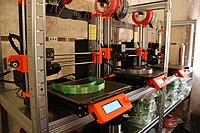
![3D file for printing a face shield[4]](https://upload.wikimedia.org/wikipedia/commons/thumb/b/be/Headpiece.stl/200px-Headpiece.stl.png)
